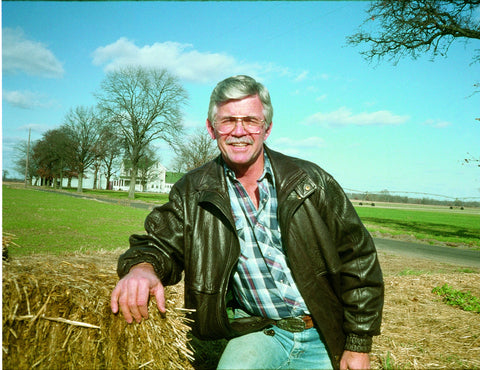Welcome to Book of the Week – a weekly feature of an Acres U.S.A. published title offering you a glimpse between the pages! Get the Book of the Week email newsletter delivered directly to your inbox!
This week's Book of the Week feature is Hands-On Agronomy, by Neal Kinsey & Charles Walters.
Add Hands-On Agronomy to my cart.
From Chapter 15: A Grower's Purpose
Every consultant should strive to teach that a farmer needs a complete fertility program, not just for the crop, but for the benefit of everything concerned—the farmer or grower and his posterity, as well as the soil chemistry, physics and biology of the land. It is not merely a matter of selling the idea of a soil test. Although a good, dependable soil test is mandatory, there has to be a program to accomplish what will profitably work for all concerned. As part of our service we strive to teach the fact that the products applied must fit into the plan. It is our policy never to tout a specific product and then try to build a program around it. It is our purpose to try and determine where you are and then recommend the products that are most readily available and will accomplish this goal most economically. If that does not happen, everyone loses. Both ends of the equation need to encompass ways and means available to accomplish the grower’s purpose.
Let’s say you have a farm and you would like to produce in the most economical way, but you can’t use manure. Or, if you have manure and can spread it, then we at least need to know what type of manure it is and what it contains by analysis. Once that information is available, we are ready to face reality. At that point our job is to help the grower understand and utilize the materials required. Our company is not in the fertilizer business—we sell a service as soil fertility specialists, and the farmer or grower, not us, chooses the supplier, and, in the end, the products he decides to use.
So far, in the establishment of a needed program, we have looked at the structure of the soil, its composition—minerals, humus, air and water. We have looked at these in terms of chemistry and we have looked at them in terms of physics. But chemistry and physics can supply only two-thirds of the answer. For the full answer, we must also look at the biological side of the soil. In most instances, the biological side of the grower’s equation gets slighted. For reasons that escape me, farmers are not quite as interested in biology, although that seems to be changing somewhat in recent years. Yet many do not realize they have to have 25% air and 25% water in the soil system. Why is that? Microbes require that balance of air and water to live and properly do their job. Sandy soils generally have too much air and not enough moisture.
In a heavy clay soil, the mix goes the other way. We get more water saturation and not enough air space. There is less pore space because colloids stick closer together. So the biology of the soil needs the exact physical and chemical mix detailed here to function as it should. Examine soils and you will conclude that every time the texture changes, so does the soil’s ability to absorb moisture and deliver nutrients. Topsoil has to be completely saturated before water will penetrate into the next layer. When soils are worked, a chisel plow or offset disc is normally to be preferred over a moldboard plow. Unlike a moldboard plow, either implement will help keep nutrients and residues near the top where they can accomplish the most benefit. By way of contrast, a moldboard plow turns over the soil, creating a new and generally hostile environment for the microbes present.
William A. Albrecht always stressed that if you want to do it right, look at nature and determine the proper pattern, then try to get as close to nature as possible.
Even a disc or a chisel plow keeps coarser particles on top, with the finer particles sifting downward. This can actually create a silt layer in the soil when worked at the same depth all the time. What difference does it make? You have to keep the soil open so that there are avenues for the water to travel through. Say that the first two-inch layer has more sand. It has to become saturated before water will penetrate the next layer. Then that layer has to be saturated before it allows water to move into the next layer. The soil system works best with coarse particles on top, with medium and fine particles below.

When Mount St. Helens erupted in Washington state, I was in touch with a good friend who worked as a consultant in the area. A lot of farms had an inch of volcanic ash deposited on top of the soil. That ash was a finer textured material than the soil itself. He analyzed the ash for its nutrient content. He also wanted to see what the fines were, what the medium sizes were, and the character of the heavier soils. That volcanic ash matched out to a silty type soil.
The topsoil where he was working was a sandy type soil. The farmer who used a moldboard plow to turn under the ash created a new water barrier. If you have coarse sand on top, and then you put a silt layer down, all that sand has to get completely saturated with water before it will move into the silt layer. Then—if you have enough moisture—if you can keep it coming in, it will finally penetrate the silt layer and move down below it. When the plant wants to pull moisture back up, the task becomes nearly impossible if water didn’t get past the silt layer. It has to complete the saturation process before water can wick back into the top. Farmers who knew enough to mix the volcanic dust into the top six inches of soil didn’t have the problem created by those using a moldboard plow.
Any time you get a different consistency in terms of texture, you are impeding water movement. You can get some sediments near the surface if the soil is not kept open. The first key to keeping pore space open is to keep a proper calcium saturation. The second key to keeping it open is to minimize compaction. And a third key is to offset compaction if indeed it occurs. A water penetration problem is also a root penetration problem. When you begin to see a uniform brown color throughout the topsoil layer, you can know that something is working in the right direction. When the lower portion is gray or yellow in appearance, it indicates that soil will need extra help. A soil conditioner works well in this regard. Just keep the top 6.75 inches open and we have effectively canceled out the need to worry in terms of initial water penetration. But when the top is skinned off down to a subsoil level, then new problems arrive. Roots will not penetrate properly unless hardpans are eliminated.
Learn more about Hands-On Agronomy here.
Add Hands-On Agronomy to my cart.
About the Authors:
Neal Kinsey grew up in southeast Missouri and worked on the farm for his father until he graduated from high school. To pay his way through college, he worked part-time and summers as a crop reporter for the USDA’s ASCS in Missouri and Illinois. He obtained his B.S. degree, and in the fall of 1966, Neal enrolled in a master’s degree program at University of Missouri, Columbia.
In 1968, Neal and his wife, Linda, moved to Texas, where he eventually became a certified consultant for Brookside Farms Laboratory of New Knoxville, Ohio. In 1977, Neal established Kinsey Agricultural Services, and now works with growers in all 50 of the United States.
Charles Walters founded Acres U.S.A. and completed more than a dozen books as he edited the Acres U.S.A. magazine, while co-authoring several more. A tireless traveler, Walters journeyed around the world to research sustainable agriculture, and his trip to China in 1976 inspired others. By the time of his death in 2009, Charles Walters could honestly say he changed the world for the better.
More by Neal Kinsey:
Browse the Neal Kinsey Audio Lecture Collection and learn more about agronomy!
MEET NEAL KINSEY IN PERSON!
Neal Kinsey will be making an appearance at the 2019 Acres U.S.A. Eco-Ag Conference & Trade Show this Dec. 9-12 in Minneapolis, Minnesota. On Dec. 9, he will be hosting an Eco-Ag U workshop, Foundations for Soil Health. Then, on the 11th, Kinsey will host the seminar The Critical Role of Magnesium in Our Soil during the Eco-Ag conference.

More by Charles Walters:
Browse the Charles Walters Collection for all of his titles and works.
Titles of Similar Interest:
- Soils & Agronomy DVD Seminar, by Arden Andersen
- Organic No-Till Farming, by Jeff Moyer
- Advancing Biological Farming, by Gary Zimmer and Leilani Zimmer-Durand
Other Excerpts to Enjoy:
- Book of the Week: Foundations of Natural Farming
- Book of the Week: Humusphere
- Book of the Week: Secrets of Fertile Soil
Share:

1 comment
Excelente material. Trabalho com consultoria Agricultura Familiar, produtores com uma média de 2 há. As informações que acabei de ver nesse site, muito me ajudará a atender os pequenos agricultores de minha região.
Muito obrigado!
José Carlos de Oliveira on